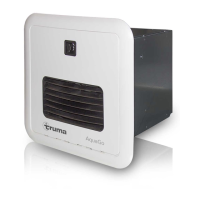20
Tasks outside the RV
• Switch the appliance OFF at the POWER
switch (red error code LED 2 (Fig 8) flashes
before it switches off).
• Drain the water System (refer to “Drain-
ing the water and cleaning the water inlet
filter” on page15, steps 4. to 8.).
• Install the water inlet filter* referring to step9.
* or antifreeze cartridge if electric antifreeze
kit is installed.
• Switch ON the appliance at the POWER
switch.
• Insert and close the access door (refer to
“Closing the access door” on page9).
You have to switch the appliance off and
on to unblock decalcification and enable
further operation.
g) Filling the water system
Tasks within the RV
• Turn on fresh water supply or switch on
water pump.
• Fill the water system.
– Open all water-release points, e.g., hot
water faucets, showers, toilets .
– Once water flows uniformly, the water
system is vented.
– Close the water-release points.
• Before you use the water system and the
appliance, check the color of the water at
all faucets:
– Slightly red –> rinse again.
– Clear –> decalcification is finished.
• Remove the warning signs “Caution decal-
cification in progress”.
Interrupting decalcification
Decalcification is indicated through slow
flashing (1s on, 1s off) of the status LED 3
(Fig. 9) on the control panel.
• Decalcification can be interrupted by switch-
ing the control panel to “Off”.
– Decalcification is interrupted after about 2 s.
– The status LED 3 (Fig. 9) on the control
panel flashes quickly.
• Irritation of skin and eyes in
case of contact with decalcification agent.
Wear protective gloves, eye protection and
face protection to avoid contact.
• First you must take out the water inlet filter
and remove any Truma AquaGo® decalcification
tablets that it may contain.
– To take out the water inlet filter, see
“Draining the water and cleaning the wa-
ter inlet filter” on page15.
– Dispose of Truma AquaGo® decalcification
tablets in accordance with local laws and
regulations.
• Before you use the water system again, you
must rinse it (see step f) “Rinsing the water
system” on page19) and fill it with water
(see step g) “Filling the water system” on
page20).

